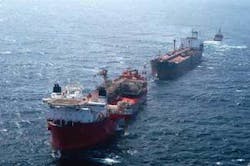Statoil believes the disconnectable FPSO is a feasible development solution in the hurricane-prone Gulf of Mexico. This type of floating production system is equipped with an internal disconnectable mooring system which allows it quickly to move away from impending harsh weather conditions to mitigate risk to the crew and infrastructure.
The company points to its experience operating a disconnectable FPSO on the Lufeng 22-1 field in the South China Sea, where tropical cyclones and other damaging weather conditions are common. The cyclones can average wind speeds of 18-22 km/h (11-14 mph), with 50 km/h (31 mph) maximum over an average duration of 26 hours, which can generate waves up to 8 m (26 ft) high. The sea also is subject to a cold wave from Siberia, which can cause Force 6 winds (22-27 knots or 25-31 mph) and rough seas.
Lufeng, FPSO Munin
Statoil operates Bluewater’s disconnectable FPSOMunin on the Lufeng 22-1 field in the South China Sea. The FPSO has been disconnected 10 times without incident, and it has dropped its buoy an additional nine times to avoid an impending threat since the field started producing in Dec. 1997.
Lufeng is in 330 m (1,083 ft) of water, about 250 km (155 mi) southeast of Hong Kong. Statoil holds a 75% working interest in the field, and the China National Offshore Oil Corp. (CNOOC) holds the remaining 25%.
Lufeng is being developed with an FPSO and five-well subsea production system. The wellstream is lifted through two 178-mm (7-in.) flexible risers boosted by electrically-driven subsea pumps that are connected to the FPSO by umbilical.
The FPSO is an upgraded version of the multi-purpose ocean-going single-screw tankerNavion Munin. It is fitted with diesel electric propulsion and two 2,000-kW electrically-driven side thrusters. Controllable pitch propellers are installed on the bow and two, 3,000-kW retractable azimuth thrusters are in front of the pump room. The vessel can process 60,000 b/d of oil, which is offloaded to shuttle tankers for export.
The FPSO’s mooring system is designed to withstand weather conditions up to the equivalent of a 25-year cold wave with Hs = 7 m (23 ft). Hs is the mean of the largest 1/3 of waves recorded during a sampling period. The vessel’s mooring also can handle a 6-knot soliton - a subsea wave that creates extreme current velocities.
Disconnection criteria, procedure
For a tropical cyclone to become a threat to the FPSO at Lufeng it has to develop into a typhoon with wind speeds greater than 64 knots (74 mph). Typhoon warning systems are in place on the FPSO. They include alert zones with corresponding actions depending on the storm’s distance from the FPSO. The alert zones are not absolute, so the directed action can be initiated at an earlier stage depending on the strength of the typhoon and its direction and speed.
The following criteria also are taken into account to make a decision:
- Max Hs = 7 m (23 ft) for disconnection
- If offset exceeds 45 m (148 ft), the buoy shall be dropped
- Restrictions on FPSO motions for safe preparations of disconnection in the STP room.
For re-connection after the typhoon has passed, the limitation is on the DP system:
- Max Hs = 4.5 m (15 ft)
- Wind speed 25 - 30 knots (29-35 mph).
The FPSO can disconnect in four to eight hours. A controlled shutdown can take up to 12 hours.
During disconnection, the field’s subsea pumps are stopped, and the FPSO’s turret with umbilical and risers are disconnected from the vessel. The unit’s turret buoy submerges 30 m (98 ft) deep where it can be retrieved for reconnection once the threat has passed.
The buoy then is pulled into the vessel’s mating cone, which is connected to the mooring and riser system. The outer buoy rotates around the turret, which allows the FPSO to weather-vane freely. The swivel/rotating connector transfers wellstream, signals and power from the geo-stationary risers to the vessel’s piping/cabling system. Two, 178-mm (7-in.) production risers, one power cable, and one umbilical are connected to the turret.
Deepwater application
The disconnectable FPSO used on Lufeng 22-1 and on other fields like Terra Nova and Pierce, also can be adapted to deepwater areas in the Gulf of Mexico for instance where hurricanes pose a threat to field installations.
The greatest challenge with deeper water is the increased weight of the riser system and corresponding buoyancy requirements for the turret. A hybrid riser system where the vertical top tensioned part of the riser system bridges the water column circumvents this problem. The flexible jumpers would be similar to the ones used in shallow water applications.
Lesson learned
The following lessons learned have been incorporated into the ongoing development of disconnection systems:
- Simplify the design of the system for disengaging and re-connecting the turret buoy
- Improve the working environment in the turret buoy room during disconnection
- The topside portion of a subsea pump is an important part of the overall system
- The pump mechanical seals are one of the most important parts of the subsea pumps
- Water ingress into the electric motor will lead quickly to electrical failure
- Take special care in the design and manufacture of subsea electrical connectors
- Robust pumps and system design is needed to gain acceptable availability
- Rotating equipment can be installed subsea for a long period of time with acceptable availability.
Acknowledgements
The authors would like to acknowledge the Lufeng 22-1 license, Advanced Production and Loading AS and Framo Engineering AS for their cooperation and permission to publish this work.







